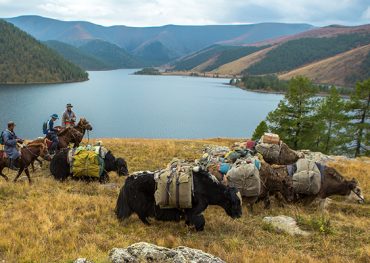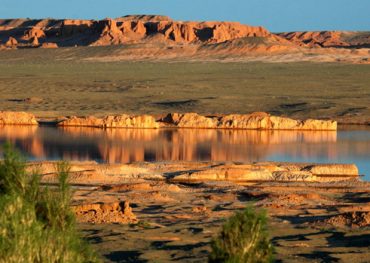From the Gobi desert to the northern Taiga, passing through the vast valleys surrounded by the Khangai mountains, live the adventures enriched by meeting with the breeders in their nomad settlement and cultural and historical visits.
You will feel closer to nature when you spend the night in a tent, in a guest yurt as an alternative with a few nights in furnished yurt camps …
Itinerary
As you arrive at the Chinggis Khaan international airport in Ulaanbaatar, the capital city of Mongolia, your guide-interpreter and driver will welcome you at the airport and lead you on to the city tour. The capital has plenty to offer. On the tour you will visit the Gandan Monastery, a historical and spiritual Buddhist temple in the city. Then you can walk around the National History Museum and the Chinggis Khaan Square in front of the Mongolian Parliament house to help you get a general knowledge and information about the Mongolian history and culture.
FB, Night in a tourist hotel
After breakfast at the hotel, with your trip team you will depart to the southern region to reach the Baga Gazriin Chuluu, massive granite formations in the middle of the dusty plains. Attention, the road is not all asphalt and is full of potholes. Still, at your destination the view is beautiful: an undulating landscape with horses, cows, sheep and goats grazing in the vast landscape, occasionally herded by a horseman with a lasso on a long stick in his hand.
Walk in the frame to visit the ruins of the monastery, destroyed in the years of massive purges, and a small spring revered by the local people.
FB, Overnight in a yurt camp
The tour continues and you descend further south by 4 × 4 to the Tsagaan Suvraga (White Stupa) located in Ulziit Soum, Dund-Gobi province. The name is given by local people to the impressive and legendary cliff which has been eroded by nature. Having 10 million years of history, the cliff indicates different eras through its colored layers. Tsagaan Suvraga is interesting to see, with its sheer slope facing east, which from a distance seem like ruins from an ancient city.
FB, Overnight in tent
On this day, your team will reach the Gurvan Saikhan National Park. The park hosts more than 200 bird species and you can find more than 600 different plant species. There are gazelles, gerbils and even snow leopards. After visiting the small museum of Yoliin Am (“Vultures valley” in Mongolian), you can take a nice stroll through the valley which ends by a chasm. If you are lucky you can see one of the massive vultures who habit there, which also gives their name to the valley.
On foot or on horseback, you move into the groove formed by the riverbed, and might be surprised to find a small hidden glacier believed to be eternal.
FB, Overnight in a yurt camp
Continuing the trip, you arrive at the national park of Khongor with its spectacular sand dunes like Duut Mankhan, meaning the singing dune. The dunes extending up to the foot of the high Altai Mountains range, lie about 180 kilometers from Dalanzadgad. It is at a distance of 130 kilometers along the desert tracks to Bogd in Uvurkhangai in the north, and 215 kilometers to Bayanlig on the northwest in Bayan Khongor. Travel through the desert is either by camel rides or by cars with drivers who are knowledgeable about the desert.
FB, Overnight in a yurt camp
After breakfast, with your team you will depart to Bayanzag, also called the Flaming Cliffs (Flaming Rocks). The rocky landscape gives a glowing orange color, like its name suggests. This is the region, in the Gobi Desert, where dinosaur fossils have been found. American paleontologist Roy Chapman Andrews gave this region its name after he visited it and found dinosaur eggs in 1920. These eggs not only established that all the dinosaurs were oviparous, but also inspired a certain Steven Spielberg for Jurassic Park. Other discoveries have also been made in the area such as the remains of a velociraptor. You can then continue for a hike in a forest of Saxaul, a tree native to the deserts of Central Asia.
FB, Overnight at the camel herder's
Leaving the Gobi Desert after breakfast, you will be continuing your journey in direction of the ruins of Ongi monastery.In the last century, Ongii Khiid was one of the largest monasteries in Mongolia with a vast group of 28 temples which could accommodate hundreds of lamas. However it was destroyed in 1939 during the Stalinist purge of religious and cultural heritages. With time, the Buddhist activity is slowly rising here from the ashes with a small school where young monks are again educated.
The temple's peculiarity is that it separates into two parts, on one side and on the other of the banks of the Ongi river. You arrive at the ruins early in the afternoon and can spend the day exploring the ruins of Ongi, some petroglyphs in the rocky masses, its small museum and the landscape around.
FB, Overnight in a yurt camp
Today, your team will drive towards the Orkhon Valley, which was inscribed by UNESCO as a World Heritage (one of a few in Mongolia) as representing evolution of nomadic pastoral traditions and includes numerous archaeological remains dating back to the 6th century. The beauty of the natural site consists not only of green plains and hills bursting with basalt lines extending on both sides of the Orkhon River, but also of deer steles, hirgesuur (tombs in cairn), tombs with slabs, anthropomorphic and zoomorphic statues, ruins of ancient capitals.
At the end of the day, you will arrive at the “URSA MAJOR” geolodge camp, located on the valley. At night, when the sky is clear, you can stargaze by MEADE LX-200, the most powerful telescope in Mongolia. You can observe the stars, planets and galaxies from the steppes of the Orkhon Valley…
PC, Cozy night under a yurt in “URSA MAJOR” geolodge
Early in the morning, you will depart to Karakorum. Upon arrival start the tour of Karakorum, the ancient capital of the Mongol Empire during the time of Chinggis Khaan (1162-1227). There are some remains of the city scattered to see around. However, most stones of the old buildings were later used to build the nearby “Erdene Zuu” Monastery.
Erdene Zuu means’ hundred treasures. The building dates from 1586 and once consisted of more than a hundred temples. Sadly, the complex has been subjected to many political ups and downs, at last being actively restored since 1990 around twenty remain today. It is one of the cultural and spiritual highlights in Mongolia. The complex is fully fenced and every fifteen meters there are stupas, 108 in total, in the walls.
You finally arrive at Tsenkher, famous for its hot springs from which the water naturally spurts out at a temperature of 86 ° C… In the afternoon, you can relax in your yurt camp’s spas.
FB, Overnight in a yurt camp
In the morning, your cross paths with the small town of Tsetserleg, a capital of Arkhangai province (the northern Khangai), which is set in a beautiful area. This town, its name also meaning “Garden” in Mongolian, with a population of about ten thousand, lives mainly off its herds of horses and the production of rich wood. Continuing, to the Chuluut river, you'll then reach the outskirts of the white lake of Terkh, and set off for a hike at the foot of Mount Khorgo, an extinct volcano that has studded the region with lava stones.
FB, Night in a yurt camp.
Today you will head for a small lake perched 2,300 meters above sea level. On the way, you will have plenty of time to visit authentic nomad families who greet you, and enjoy their hospitality. You may have a taste of “White food” and notably Airag, a strong traditional drink made from fermented mare’s milk. On arrival, you set off for a walk or horse ride on the shores of Lake Zuun (Lake Left).
FB, Overnight in yurt.
Departure in the morning to the small town of Khatgal, south of Lake Khuvsgul. Like every day, you’ll meet herders there with whom you’ll share warm moments. Once there, you spend the rest of the day by the largest freshwater lake in Mongolia, the Khuvsgul Lake whose beauty you can admire on foot or on horseback.
FB, Overnight in a yurt camp.
We reserved this full day for you to fully enjoy the region. In the morning you take your backpack and leave for a beautiful hike in the forest on the slopes of Mount Khyasa. You’ll picnic at the top with a grand view to the east on Lake Khuvsgul and to the west on the Khoridol Saridag mountain range.
In the afternoon, you return to the camp where you can take all your time to rest and make friends with the locals.
FB, Overnight in a yurt.
Today you’ll be on your way to the village of Ikh Uul. On the road you stop to discover the deer steles from the Ushigiin Uvur region, the artistic vestiges of the Bronze Age. You arrive at Ikh Uul village and can set up your tents.
FB, Overnight in tent.
You start this day by surveying the ruins of an old Silk Road trading post, one of few left by the Uighurs, whose Uyguro-Mongolian writing offered the country a legacy in the 8th and 9th centuries. You reach the natural reserve of extinct volcanoes Uran and Togoo. After a vigorous ascent you can enjoy its beautiful panoramic views.
FB, Overnight in tent
After a stopover in the city of Erdenet, the second largest city in the country thanks in particular to its open-pit copper mine, you’ll approach the vast expanses of Mongolian steppes in the direction of the Amarbayasgalant monastery, a popular pilgrimage site, one of the most beautiful monasteries of Mongolia today and whose name meaning “quiet bliss” rings true.
FB, Overnight in tent.
After breakfast you return to the capital Ulaanbaatar and arrive at your hotel. Take this time to have a little rest, then you’ll go shopping in the State Department Store, the largest shopping mall in Mongolia, a leftover of the Soviet occupation. There, you can find cashmere, leather, and whatever you want for souvenirs, presents and gifts.
In the evening you’ll indulge in Mongolian culture with a folklore show, concert of traditional music and contortion. You’ll hear performances with the Traditional Mongolian instrument Morin Khuur, a two-string fiddle adorned with a carved horse’s head; overtone singing, previously only used by shamans to enter into communication with the spirits.
At last, a farewell dinner with your team to wrap up an excellent journey full of memories.
FB, Night in a tourist hotel
After having breakfast in the hotel, your team will drive you to the “Chinggis Khaan” international airport 2 hours before your departure.
Have a safe journey back!















